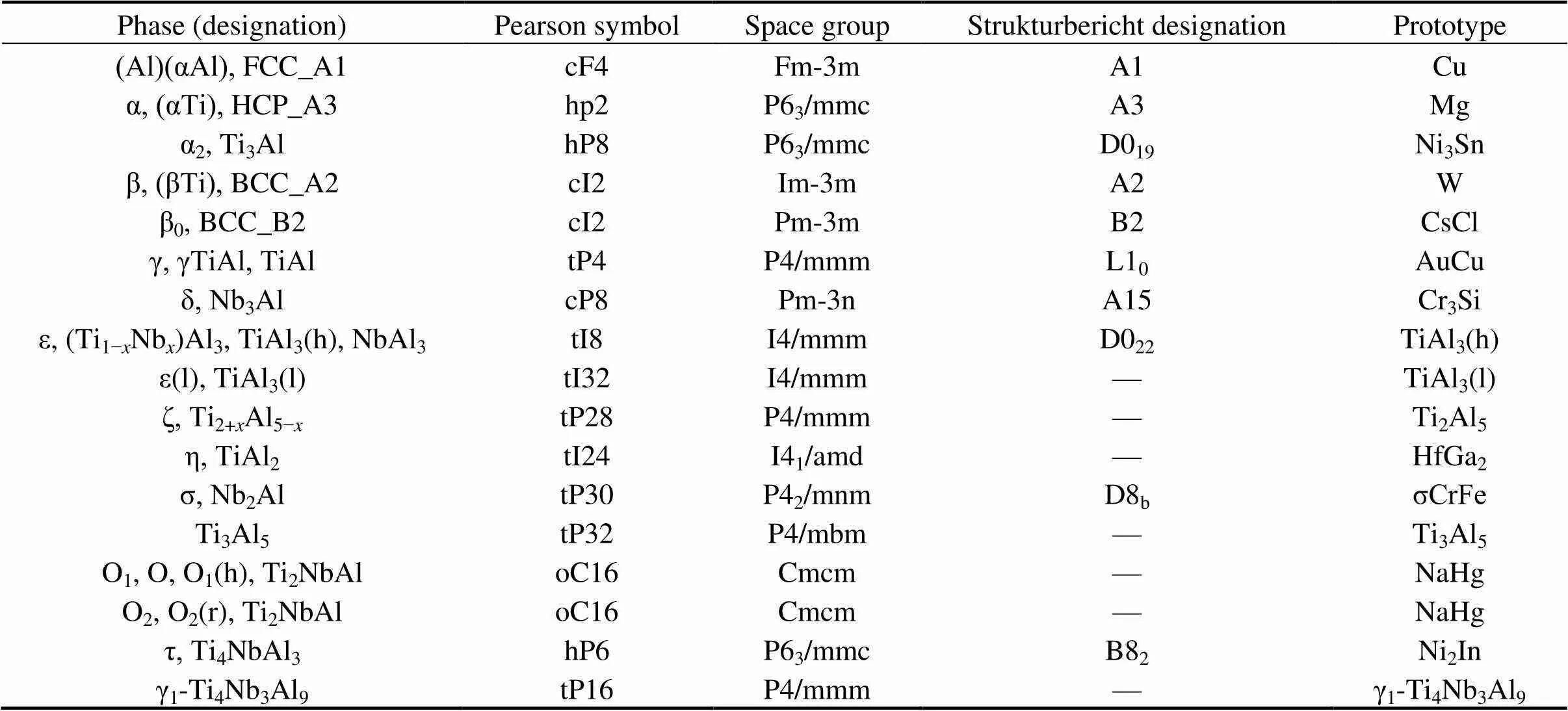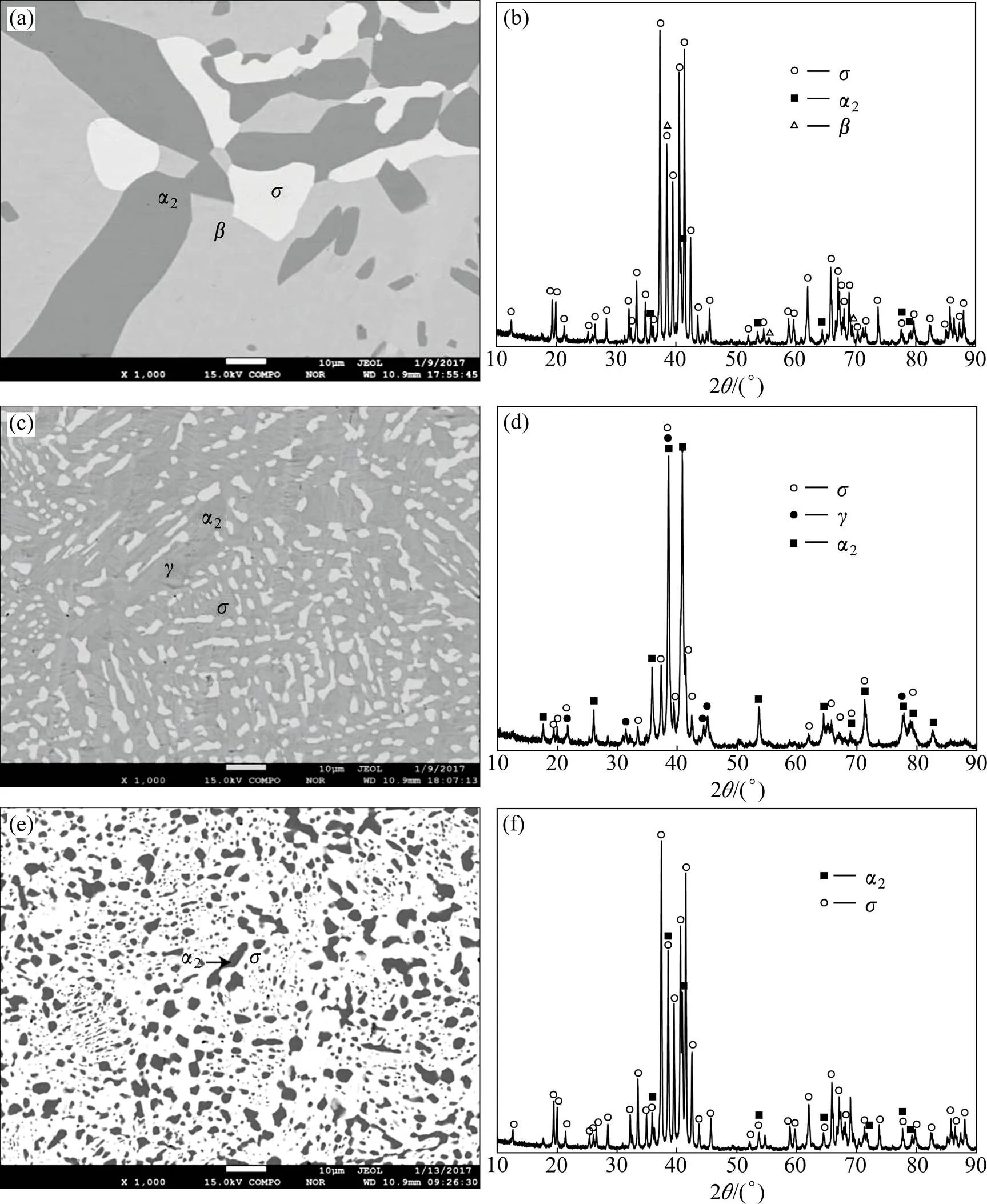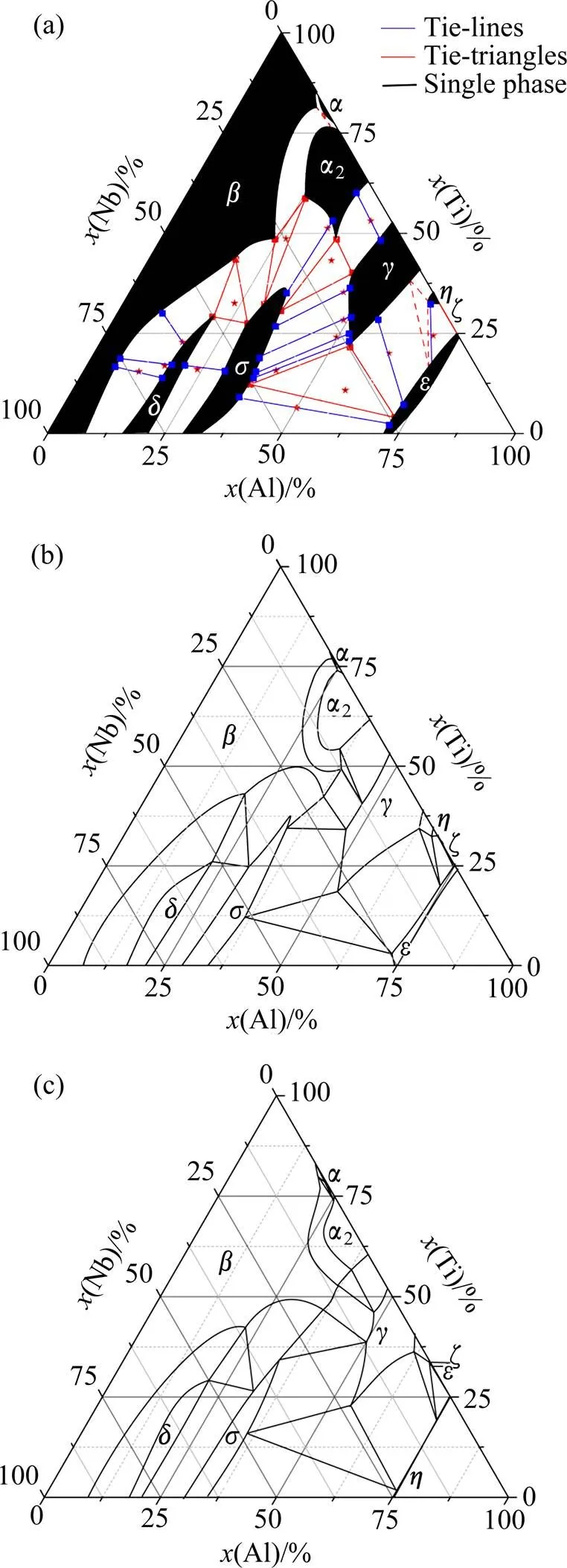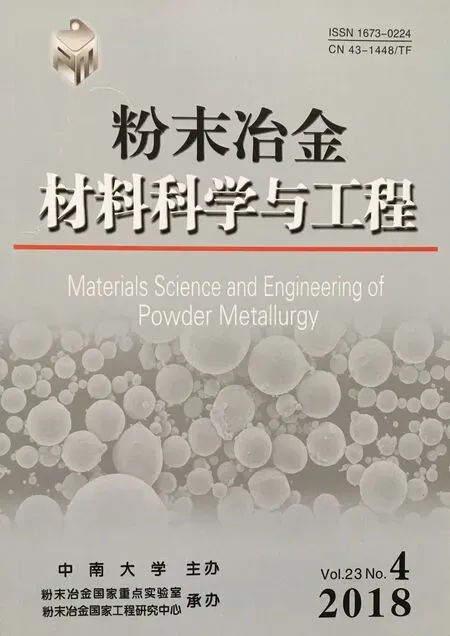Ti-Al-Nb三元系1 100 ℃等温截面的研究
李林,刘立斌,章立钢
Ti-Al-Nb三元系1 100 ℃等温截面的研究
李林,刘立斌,章立钢
(中南大学 材料科学与工程学院,长沙 410083)
采用电弧熔炼法制备17个不同成分的Ti-Al-Nb三元合金样品,在1 100 ℃退火1 080 h后取出,在冰水中淬火。利用扫描电镜(SEM)、电子探针(EPMA)和X射线衍射(XRD)等手段对退火后的合金样品进行分析,研究Ti-Al-Nb三元系1 100 ℃等温截面,确定该截面下(Al摩尔分数为0~75%成分区间)的9个单相区、15个两相区和7个三相区,并与Witusiewicz与Cupid的优化计算结果进行比较。结果表明,本研究所得1 100 ℃等温截面的Al摩尔分数为30%~60%的成分区间与Witusiewicz和Cupid的计算结果存在明显差异。采用实验方法确定了Ti-Al-Nb三元系1 100 ℃等温截面与计算结果不同的α2+β+γ和β+γ+σ两个三相区以及β+γ两相区。
TiAl合金;金属间化合物;相图;微观结构;等温截面
TiAl 金属间化合物密度低,高温下具有良好的力学性能,是一种非常有应用潜力的新型高温结构材 料[1−2]。Nb作为TiAl基合金的添加元素不但可以有效提高其抗高温抗氧化性能,而且可进一步提高合金的力学性能[3−6]。Ti-Al-Nb三元系含有很多有潜力的金属间化合物,它们可用来制备力学性能优异的合金[2]。最近,人们研究了Ti-Al-Nb三元系在800 ℃以上的潜力合金[7],这些合金包含的多种组织,例如γ-TiAl,α2-Ti3Al,O-Ti2NbAl,σ-Nb2Al和β有序固溶体,均可作为高温应用的候选材料[2, 8−10]。关于Ti-Al-Nb相图的信息对于钛合金的设计和制造是不可或缺 的[11−12]。三个子二元的相图,即Ti-Al[13−15],Ti-Nb[16−17]和Al-Nb[18]已得到很好地研究和优化。目前,也有用热力学方法优化Ti-Al-Nb三元相图的报道[15, 18−23]。2009年WITUSIEWICZ[18]和CUPID[19]都采用CALP- HAD(即calculation of phase diagram)方法优化了Ti-Al-Nb三元相图,但它们的结果有很大的差异,包括在1 000 ℃以上的α,β和γ相的平衡。本文作者采用电弧熔炼法制备17个Al摩尔分数为0~75%的Ti- Al-Nb合金样品,在1 100 ℃退火1 080 h后取出,在冰水中淬火,用扫描电镜(SEM),电子探针显微分析(EPMA)和X射线衍射(XRD)对退火合金进行检测,根据合金中发生相变时相变发生的点和边界进行推断来测量合金相图,研究Ti-Al-Nb体系在1 100 ℃的相平衡,丰富了航空用钛合金的基础研究数据。表1所列为文献普遍采用的Ti-Al-Nb三元系物相晶体结构[18]。
1 实验
以金属Ti、Al和Nb为原料(纯度均为99.99%,由中国金钰研材料科技股份有限公司生产),采用电弧熔炼法制备17个不同成分的Ti-Al-Nb合金样品,每个样品的质量限制在6 g,合金样品编号及其成分与物相组成列于表2。首先通过分析天平称量金属Ti、Al和Nb原料,倒入铜坩埚内(为了避免熔炼过程中铝的质量损失过大,需要先将纯铝棒放在铜坩埚底部,然后将纯铌和纯钛棒覆盖在铝棒上),在电弧炉内氩气气氛下进行熔炼,用纯钛作为吸氧剂,低电流起弧时电弧先接触熔炼钛和铌,熔融的钛铌合金将铝包裹住,然后加大电流使整个合金熔成纽扣状。为了确保熔炼合金的均匀性,至少重复熔化4次,每次熔化前将样品翻转。熔炼后样品的质量损失率不超过1%。将得到的钮扣合金样品密封在高纯度氩气石英管中,1 100 ℃退火1 080 h后,将合金取出,在冰水中淬火。

表1 Ti-Al-Nb体系常用相及其晶体结构[18]

表2 用EPMA法测定的1 100 ℃下的Ti-Al-Nb平衡相组成与各相的成分
Note: Nb content in different phases(Nb)=100%−(Al)−(Ti)
将退火后的样品抛光,用JEOL JXA-8530F电子探针微量分析(EPMA)对合金的化学成分以及各相的化学成分进行测定,成分分析的标准偏差为±0.5%(摩尔分数),检测出各相中Ti,Al,Nb的质量分数在97%~103%之间,可以忽略样品与石英管反应的影响。用Rigaku D-max/2500X辐射射线衍射仪对一些选定的退火合金样品进行XRD分析,CuKα靶,在电压为40 kV,电流200 mA下操作。用Jade 6.0对合金的各组成相进行晶体结构分析。
2 结果与讨论
通过EPMA分析,得到表2所列的Ti-Al-Nb合金在1 100 ℃下平衡状态的化学成分以及各相的化学成分。图1所示为A2#,A4#和A3#合金样品的背散射电子显微(BSE)图片和XRD谱,由表2和图1可知,A2#合金样品为α2,β和σ 三相平衡,A4#样品包含α2,σ和γ这三相。A3#合金样品为σ和α2两相平衡。

图1 1 100 ℃退火后的Ti-Al-Nb合金BSE图和XRD谱
(a), (b) A2#; (c), (d) A4#; (e), (f) A3#
图2所示为1100℃退火后的A1#,A14#,A8#,A9#,A5#,A13#,A15#,A16#和A17#合金样品的SEM背散射电子显微照片,A1#和A14#样品分别为β+δ+σ和γ+σ+ε三相平衡,A8#,A9#,A5#,A13#,A15#,A16#和A17#合金样品分别为β+δ,δ+σ,α2+γ,γ+σ,ε+σ,γ+ε和ε+η两相平衡。

图2 1 100 ℃退火合金的扫描电镜BSE图
(a) A1#; (b) A14#; (c) A8#; (d) A9#; (e) A5#; (f) A13#; (g) A15#; (h) A16#; (i) A17#
图3(a)为本研究得到的1 100 ℃等温截面以及该截面的共轭线和三相区。图3(b)和(c)分别为WITUSIE- WICZ[18]和CUPID[19]计算得到的1 100 ℃等温截面。本研究确定了α2+β+σ和α2+σ+γ两个三相区以及σ+α2两相区,而WITUSIEWICZ[18]和CUPID[19]的计算结果在该区域为α2+β+γ和β+γ+σ两个三相区以及β+γ两相区,这可能是由该截面优化时所采用的实验数据不充分所致。本研究所确定的β+σ+δ和γ+σ+ε这两个三相区与WITUSIEWICZ[18]和CUPID[19]的计算结果一致,但位置有差异,这是由WITUSIEWICZ[18]和CUPID[19]优化计算时所采用的实验数据之间的差异所致。

图3 Ti-Al-Nb合金1 100 ℃等温截面
(a) The tie-lines, the tie-triangles and the 1 100 ℃ isothermal section of phase diagram identified by the present work; (b) Calculated results from WITUSIEWICZ’s work; (c) Calculated results from CUPID’s work
3 结论
1) 采用合金法和扫描电镜、电子探针、X射线衍射等分析手段确定了Ti-Al-Nb三元系相图1 100 ℃等温截面(Al摩尔分数为0~75%成分区间)的9个单相区、15个两相区和7个三相区。
2) 本研究所得的30%~60%Al成分区间与WITUSIEWICZ[18]和CUPID[19]计算的相关系存在明显差异,确定了不同于计算结果的α2+β+γ和β+γ+σ两个三相区以及β+γ两相区。
[1] POLLOCK T M. Alloy design for aircraft engines[J]. Nature Materials, 2016, 15(8): 809.
[2] DE Aragão B J, EBRAHIMI F. High temperature deformation of NbTiAl alloys with σ+γ microstructure[J]. Materials Science and Engineering A ,1996, 208(1): 37−46.
[3] KENEL C, LEINENBACH C. Influence of Nb and Mo on microstructure formation of rapidly solidified ternary Ti-Al-(Nb, Mo) alloys[J]. Intermetallics ,2016, 69(Supplement C): 82−89.
[4] CLEMENS H, WALLGRAM W, KREMMER S, et al. Design of novel β-solidifying TiAl alloys with adjustable β/B2-phase fraction and excellent hot-workability[J]. Advanced Engineering Materials, 2008, 10(8): 707−713.
[5] KIM Y W. Ordered intermetallic alloys, part III: Gamma titanium aluminides[J]. JOM, 1994, 46(7): 30−39.
[6] SHULESHOVA O, HOLLAND-MORITZ D, LÖSER W, et al. In situ observations of solidification processes in γ-TiAl alloys by synchrotron radiation[J]. Acta Materialia, 2010, 58(7): 2408− 2418.
[7] HOELZER D T, EBRAHIMI F. Phase stability of sigma+beta microstructures in the ternary Nb-Ti-Al system[J]. Mrs Proceedings, 1990, 194 (Symposium R-Intermetallic Matrix Composites I): 393.
[8] CLEMENS H, MAYER S. Design, processing, microstructure, properties, and applications of advanced intermetallic TiAl alloys[J]. Advanced Engineering Materials, 2013, 15(4): 191− 215.
[9] DIMIDUK D M. Gamma titanium aluminide alloys-an assessment within the competition of aerospace structural materials[J]. Materials Science & Engineering A, 1999, 263(2): 281−288.
[10] WU X. Review of alloy and process development of TiAl alloys[J]. Intermetallics, 2006, 14(10/11): 1114−1122.
[11] LEYENS C, PETERS M. Titanium and Titanium Alloys: Fundamentals and Applications[M]. Hoboken, N J, USA:J Been and J S Grauman, 2006: 401.
[12] LIU Y, CHEN L F, TANG H P, et al. Design of powder metallurgy titanium alloys and composites[J]. Materials Science & Engineering A, 2006, 418(1/2): 25−35.
[13] OHNUMA I, FUJITA Y, MITSUI H, et al. Phase equilibra in The Ti-Al binary system[J]. Acta Materialia, 2000, 48(12): 3113− 3123.
[14] WITUSIEWICZ V T, BONDAR A A, HECHT U, et al. The Al-B-Nb-Ti system: III. Thermodynamic re-evaluation of the constituent binary system Al-Ti[J]. Journal of Alloys & Compounds, 2008, 465(1/2): 64−77.
[15] KATTNER U R, LIN J C, CHANG Y A. Thermodynamic assessment and calculation of the Ti-Al system[J]. Metallurgical Transactions A, 1992, 23(8): 2081−2090.
[16] KUMAR K C H, WOLLANTS P, DELAEY L. Thermodynamic calculation of Nb-Ti-V phase diagram[J]. Calphad, 1994, 18(1): 71−79.
[17] WITUSIEWICZ V T, BONDAR A A, HECHT U, et al. The Al-B-Nb-Ti system: II. Thermodynamic description of the constituent ternary system B-Nb-Ti[J]. Journal of Alloys & Compounds, 2008, 456(1): 143−150.
[18] WITUSIEWICZ V T, BONDAR A A, HECHT U, et al. The Al-B-Nb-Ti system: IV. Experimental study and thermodynamic re-evaluation of the binary Al-Nb and ternary Al-Nb-Ti systems[J]. Journal of Alloys & Compounds 2008, 472(1): 133− 161.
[19] CUPID D M, FABRICHNAYA O, RIOS O, et al. Thermodynamic reassessment of the Ti-Al-Nb system[J]. International Journal of Materials Research, 2009, 100(2): 218− 233.
[20] ANSARA I, DUPIN N, RAND M H. Thermochemical Database for Light Metal Alloys[M]. COST 507, vol. 2. European Commission, Luxembourg, 1998.
[21] SERVANT C, ANSARA I. Thermodynamic assessment of the Al-Nb-Ti system[J]. Berichte Der Bunsengesellschaft Für Physikalische Chemie,1998,102(9): 1189−205.
[22] SERVANT C, ANSARA I. Thermodynamic modelling of the order-disorder transformation of the orthorhombic phase of the Al-Nb-Ti system[J]. Calphad-computer Coupling of Phase Diagrams & Thermochemistry, 2001, 25(4): 509−525.
[23] ZHU Z, DU Y, ZHANG L, et al. Experimental identification of the degenerated equilibrium and thermodynamic modeling in the Al-Nb system[J]. Journal of Alloys & Compounds, 2008, 460(1): 632−638.
(编辑 汤金芝)
Study on isothermal section of Ti-Al-Nb ternary system at 1 100℃
LI Lin, LIU Libin, ZHANG Ligang
(School of Materials Science and Engineering, Central South University, Changsha 410083, China)
Seventeen Ti-Al-Nb alloy samples were prepared by arc melting, annealing at 1 100 ℃ for 1 080 h, quenching in ice water. Isothermal section of Ti-Al-Nb ternary system at 1 100 ℃ were studied using X-ray diffraction (XRD), scanning electron microscopy (SEM) and electron probe microanalysis (EPMA). Nine single-phase regions, fifteen two-phase regions and seven three-phase regions under the section (0−75%Al composition interval) were identified. The results show that, compared with the isothermal section of 1 100 ℃ obtained from the optimized calculation results of Witusiewicz and Cupid, there is a significant difference between experimental results (30−60%Al composition intervals) and the calculated results. The experimental results show that two three-phase α2+β+γ and β+γ+σ regions and a two-phase β+γ region of the isothermal section of 1 100 ℃ are different from the calculated results.
TiAl alloy; intermetallics; phase diagram; microstructure; isothermal section
TG146.4+16
A
1673-0224(2018)04-341-06
科技部重大专项(2016YFB0701301)
2017−12−21;
2018−02−26
刘立斌,教授,博士。电话:0731-88877732;E-mail: lbliu@csu.edu.cn

